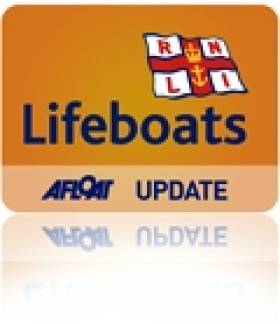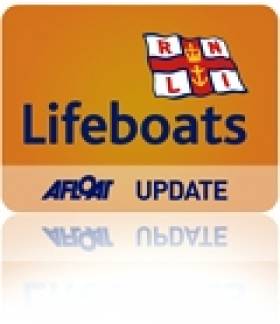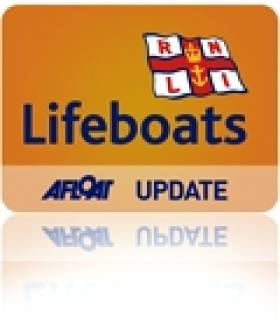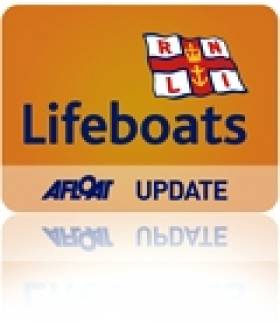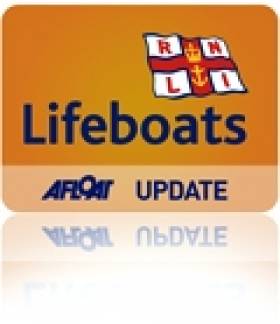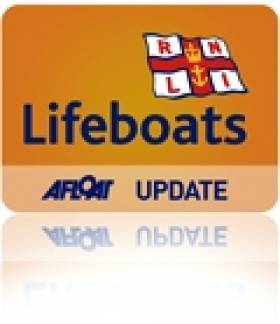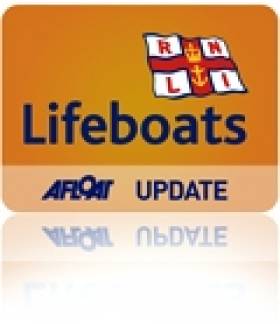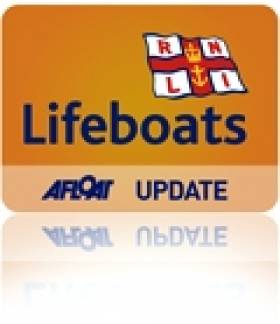Displaying items by tag: Lifeboats
Sligo Bay RNLI Celebrates 15th Anniversary This Weekend
#RNLI - Sligo Bay RNLI will celebrate its 15th anniversary this Sunday (16 June) with an open day at the lifeboat station in Rosses Point.
There will be an opportunity to chat to the crew, have a look around the station, visit the lifeboat shop and enjoy the seafaring music provided by the groups involved in the Sea Shanty Festival which is also taking place this weekend from 14-16 June.
Sligo Bay RNLI began life in a prefab cabin at Sligo Yacht Club back in 1998. Construction on the new lifeboat station situated at the pier in Rosses Point was completed in 2002. It houses a D Class lifeboat named Elsinore and has 22 volunteer crew members, along with a fundraising team and a lifeboat shop.
As part of the Sea Shanty Festival there will a gala concert in the Yeats Country Hotel on Saturday night (15 June), all proceeds from which will go the Sligo Bay lifeboat station. Tickets are available from the lifeboat station shop, Bay View Stores, Rosses Point and Source on John St in Sligo.
Elsewhere, RNLI volunteers and supporters from around Ireland were recognised for their role in supporting and raising funds and awareness for the lifesaving charity and its crews at the RNLI Annual Presentation of Awards in the Great Hall at Trinity College Dublin.
Guest of honour was the outgoing chairman of the RNLI, Admiral the Lord Boyce, who handed out awards to 51 volunteers throughout Ireland.
Irish Coast Guard director Chris Reynolds and his wife Geraldine along with Irish Water Safety CEO John Leech were also in attendance at the ceremony, presided over by the chairman of the RNLI Council of Ireland, John Coyle.
Awards presented on the day included two Gold Badges, four Silver Badges, 19 statuettes, 17 Bronze Badges, one pair of RNLI binoculars and eight Supporter Awards.
The Gold Badges were received by Jackie O’Grady from Clifden RNLI branch for his work over 25 years with the station, and to Hugh Stafford in Wexford for his role in the setting up of the Fethard-on-Sea lifeboat station in the early 1990s and his work since then in raising funds for the charity.
Also receiving an RNLI statuette was former lifeboat man at Rosslare Harbour, Fergus Wickham, who was recognised for almost five decades of volunteering with the RNLI, first as a lifeboat man and then as a launching authority at the station.
Crash With Turbine Caused Strangford Lough Yacht Dismasting
#RNLI - A collision with a tidal turbine was to blame for the incident that caused the dismasting of a yacht in Strangford Lough on Sunday 9 June.
As reported yesterday on Afloat.ie, Portaferry RNLI's lifeboat crew was dispatched to the stricken yacht in the narrows of Strangford Lough close to the SeaGen water turbine.
The local RNLI press office confirmed that three men and a teenage boy were on board the 37ft yacht at the time - though BBC News says that only three people were rescued, including a child.
The SeaGen installation in Strangford Lough was accredited by Ofgen as Britain's first tidal power plant, as previously reported on Afloat.ie.
#RNLI - Enniskillen RNLI today (10 June) brought four people to safety in two separate incidents on Lough Erne in Co Fermanagh.
In the first call-out of the day, the volunteer lifeboat crew retrieved a man and women from their stranded cruiser which had developed engine problems and run aground on Lower Lough Erne.
The inshore lifeboat Joseph and Mary Hiley and the Rescue Water Craft (RWC) were launched just before 10am at the request of Belfast Coastguard and made the 25-minute, six-mile journey to the casualty's last known position at Crunnish Island. The wind was coming from the south east, force five with good visibility.
On arrival at the scene, the crew noted the casualties had deployed their anchor and there were strong waves hitting the starboard side of the vessel.
The RWC crew member was transferred to the casualty vessel to reassure the crew and to check for any leakage. Another crew member from the lifeboat was transferred to assist with the tow and to lift the anchor.
The lifeboat established a tow and the vessel was refloated and brought to safety at Tudor Farm jetty, close to the initial location.
Less than three hours later, the inshore lifeboat Jason Logg was launched by request of Belfast Coastguard to rescue two people on a broken-down personal water craft on Upper Lough Erne.
The crew proceeded to the casualty's last known whereabouts at the mouth of Tamlagh Bay, four miles downstream from the station towards Enniskillen.
On arrival, the crew found the troubled vessel in the reeds with two people sitting on it. The crew transferred both passengers onto the lifeboat before setting up a tow and bringing the water craft back to Bellanaleck Marina.
Elsewhere in Northern Ireland, Portaferry RNLI brought three men and a teenage boy to safety yesterday afternoon after their yacht got into difficulty off Portaferry in Co Down.
The volunteer lifeboat crew was alerted just after noon following a mayday call that there was a demasted yacht in trouble on Strangford Lough.
The lifeboat was launched minutes later and was alongside the stricken vessel, a 37ft yacht located in the narrows of Strangford Lough, at 12.10pm. Weather at the time was good with clear visibility and a flat calm sea.
One of the four casualties, who had been thrown from the vessel, had been recovered by a fellow crew member and all four were on board the yacht when the lifeboat crew arrived on scene.
Alongside, there was difficulty recovering the vessel so the mast and sail were cut away. Once cut, the lifeboat proceeded to tow the yacht with it crew on board safely back to Strangford where it was tied to a mooring.
Two of the crew were conveyed to hospital while the other two were made comfortable on the shore.
Portaferry RNLI was requested to launch for a second time later this afternoon following a report that a swimmer had gone missing in Newtownards. The lifeboat having launched was subsequently stood down after the missing person was found safe and well.
Clifden RNLI Rescues Inishbofin Casualty
#RNLI - Clifden RNLI‘s Atlantic 75 lifeboat launched on Thursday afternoon 6 June in response to a coastguard request to assist in the transfer of a casualty from Inishbofin Island in Co Galway to the mainland.
A 61-year-old man, who was visiting the island, had sustained significant facial injuries following a fall from a bicycle. Clifden RNLI lifeboat helm James Mullen, a full-time paramedic, was able to assess the casualty’s injuries on arrival.
Having checked him over, he and the other voluntary crew members transported the man quickly and safely to Cleggan pier and an awaiting ambulance, which then transferred him to University College Hospital Galway for further treatment.
Mullen said of the launch: “I was glad to be available to assist on this callout to Inishbofin today. Our swift launch and recovery time is vital regarding our local islands, and while the casualty’s injuries were not life threatening, they were certainly serious enough to warrant urgent medical attention.”
Inishbofin Island is located five miles off the Connemara coast and is a popular summer holiday destination.
The Clifden RNLI lifeboats have undertaken many launches to and exercises around the island, including with the island’s main ferry. And as previously reported on Afloat.ie, the station was recently chosen to trial the new Mersey class all-weather lifebo
Larne Lifeboats In Two Separate Call-Outs
#RNLI - Larne RNLI was called out for assistance on two separate occasions this past week.
On Thursday night 6 June, the volunteer lifeboat Dr John McSparran responded to a request by Belfast Coastguard to assist a lone yachtsman who had become disorientated in sea fog.
Weather conditions at the time were described as flat calm with no wind at all. However, a sea fog had come down in the evening, and the man on board - having left Girvan in Scotland en route to Glenarm Marina in an old gaffer to celebrate the Old Gaffers Association's Golden Jubilee - got into difficulty.
The casualty was located becalmed seven miles east of The Maidens Lighthouse. Lifeboat crew members Martin Agnew and Scott Leitch were put on board to assist after it was discovered that the casualty's outboard engine had failed and the gaffer was making no headway against the tide.
It was decided by Coxswain Frank Healy to tow the casualty to Glenarm, keeping the two crew members on board to assist. The vessels and crews arrived in Glenarm at 1.30am.
Two nights before, Larne RNLI assisted two men after their motor boat got into difficulty on Belfast Lough.
The volunteer crew launched their inshore lifeboat, the Hannahbella Ferguson, at 8.15pm following a request to assist the speed boat which had sustained engine failure off Muck Island.
Two men, both wearing lifejackets, were on board. Weather conditions at the time were described as good with a flat calm sea.
The casualty boat was subsequently towed safely to shore by the lifeboat to Portmuck Harbour.
Crew on this call out included helm Willie Evans, Martin Agnew and Jay Torbitt.
RNLI Lifeboats Have Busy June Bank Holiday Weekend
#RNLI - It was a busy June bank holiday weekend around the country for RNLI lifeboats in West Cork, Mayo and the Midlands.
On Sunday afternoon, Baltimore RNLI assisted four people after their yacht got into difficulty a mile south of Mizen Head.
The 32ft yacht with four people on board had been propped by a pot buoy immobilising her in the water. The alarm was raised at 10.41am and lifeboat the Alan Massey was launched minutes later.
A local RIB, which had commenced towing, passed the tow to the lifeboat and the yacht was then taken to the safety of Crookhaven Pier.
This was the second call out this week for Baltimore RNLI. On Thursday last three men were rescued when their punt overturned near Horse Island.
Later on Sunday, Achill Island RNLI in Co Mayo brought a distressed fishing vessel with seven people on board to safety.
The volunteer lifeboat crew was requested to launch at 4.50pm to assist a small fishing vessel in the vicinity of Clew Bay and close to Clare Island. The vessel had encountered engine problems and was unable to return to port.
The boat and its crew of seven were subsequently towed safely to Curraun harbour by the Achill Island RNLI lifeboat.
Speaking after, Achill Island RNLI lifeboat operations manager Tom Honeyman said: "The presence of thick fog surrounding the vessel meant that great care was needed in the rescue and the fishing party of the vessel were delighted to return empty handed for a change."
Meanwhile in the Midlands, Lough Ree RNLI brought five people to safety in two call-outs over the weekend.
On Friday 31 May the volunteer crew was requested to launch around 5pm following a report that a cruiser had ran aground north of Quaker Island.
A local fisherman raised the alarm after spotting the cruiser on the rocks at the island located in the north end of Lough Ree raised the alarm.
The lifeboat crew managed to establish contact with the person on board the cruiser via mobile phone and he had confirmed that he had got lost and had ran aground. He reported that there was no water entering his boat. He was on his own but not injured.
The inshore lifeboat was launched and the crew was on scene at 5.30pm. It took the lifeboat 10 minutes to safely navigate its way through the rocky area to reach the casualty. The person on board the cruiser was taken to shore and arrangements were made for a specialist company to attend the scene to recover the cruiser.
Lough Ree RNLI was then launched on Sunday evening to assist a 26ft cruiser which had ran aground east of Green Island after sustaining engine failure.
The small cruiser with a family of four on board had lost engine power and had ran aground on the south east side of Lough Ree.
A crew launched the lifeboat at 8.40pm and arrived on scene 10 minutes later. After one of the lifeboat crew had carried out an assessment of the causality vessel, the decision was made to make an attempt to pull the vessel from the rocks, which the lifeboat was successfully able to complete.
Once the lifeboat had the vessel in deep water, a tow was set up and the casualty vessel was taken to Quigleys Marina in Athlone.
It marked the continuation of a dramatic week for the Lough Ree crew, after six were rescued from a sinking cruiser on the lough last Tuesday 28 May.
#RNLI - Kilrush RNLI in Co Clare was diverted from exercise training on Tuesday 28 May when the lifeboat came to the assistance of a 10ft boat.
The volunteer lifeboat crew at Kilrush were returning from their weekly training exercise at 8.45pm when they were requested to go in search of a vessel that had lost its moorings at Tarbert pier.
After relaying the situation to the Coast Guard at Valentia and getting permission to launch, the inshore lifeboat Edith Louise Eastwick set off to the Tarbert area and carried out an extensive search. Weather conditions at the time were blowing force three to four northerly winds.
The crew continued eastwards and crossed over to the Labasheeda region where they located the 10ft punt off Kilkerrin Point.
After securing the vessel to the lifeboat, the crew brought it back to Tarbert pier where the owners were waiting. The vessel was handed over and a request that a new mooring line be put in place was made.
The call out was crew member Charlie Glynn’s first as helm, having secured the position a month ago.
Earlier that day, Enniskillen RNLI was launched to reports of a cruiser which had run aground on Lower Lough Erne in Co Fermanagh.
The volunteer crew on their inshore lifeboat Joseph and Mary Hiley and the Rescue Water Craft (RWC) proceeded to Inish Davar, two miles from the station. Weather at the time was clear with calm waters.
The crew arrived at the location to find the owner of the vessel on another boat and assisting the casualty boat and the two men and two women who were on board and safe and well. The lifeboat crew stood off and observed from a distance.
New Lifeboat Station For Upper Lough Erne
#RNLI - Enniskillen RNLI is to get a new lifeboat station at its Carrybridge base on Upper Lough Erne, it has emerged.
Planning permission for the new build has been passed by Fermanagh District Council and the RNLI’s tendering process is now underway, with a view for building work to commence in late summer.
Once complete, the modern station - much like the new facility for Castletownbere RNLI that opened recently - will replace the existing temporary accommodation which has housed the charity’s volunteer lifeboat crew for the past 11 years.
In order to facilitate the project, the local community is being asked to help the RNLI raise £60,000 (€70,000) towards the cost, which will help Enniskillen RNLI continue to save lives on Lough Erne.
In 2001, Enniskillen became home to the RNLI’s first inland lifeboat station based on Lower Lough Erne.
Due to the overall size and complexity of the lough and its high leisure usage, the decision was taken by the RNLI in 2002 to base a second lifeboat on the upper lough that would work in conjunction with the original lifeboat station on the lower lough.
With two bases, two inshore lifeboats and two rescue water craft, the station has since proved to be one of the busiest in Ireland.
Last year alone, Enniskillen RNLI launched 46 times bringing 50 people to safety. Some 20 of those services were carried out in the dark while the crew spent 169 service hours on the water.
RNLI divisional operations manager Gareth Morrison said he was delighted that planning had now been approved making way for what will be a purpose-built station in a location close to the lough allowing for an efficient launch.
"In an area that receives over 100 days of heavy rainfall a year, it is hard to believe the volunteer crew based at the upper lough operate from just a temporary facility, partly exposed to the elements," said Morrison.
"The crew has to change in a small, damp, metal container and only has a portaloo and wash basin for their comfort. There is nowhere for the crew to shower or dry after a challenging rescue and nowhere for them to gather and train together during the week.
"We want to build a modern station with full crew facilities with areas for the crew to change and train and space to keep their lifeboat and rescue water craft and lifesaving kit safe."
Enniskillen RNLI lifeboat operations manager Davey Robinson said a new station was what the crew deserved.
"At the moment we are operating out of a temporary facility. It is cramped and there are no showers so the crew cannot warm up after a cold, wet and tiring rescue. A new station will be great for the crew. We are a busy station so it is what they deserve."
He added: "It is always reassuring for locals and visitors alike that the RNLI is here to assist them or help their loved ones when they get into difficulty. We try to act as a safety net on Lough Erne and are here 24 hours a day. But we need the right facilities to do that and this new station will help."
Donations and other assistance with fundraising are welcome. For details contact Tony Hiney, RNLI community fundraising manager, at 087 219 8917 or email [email protected].
#RNLI - The volunteer lifeboat crew at Kilmore Quay RNLI in Co Wexford had a busy time last week with five call-outs in seven days.
In the first incident on Monday 13 May, a French 6.5m yacht with two people on board got into difficulty as it was taking part in a 'mini Fastnet' yacht race.
The vessel’s crew decided to make for Kilmore Quay due to adverse weather. The yacht had no engine due to race rules and so the lifeboat was reqested to help the crew safely get into the harbour.
The second call-out came last Wednesday evening (15 May) when a member of the public reported to Dublin Coast Guard that a yacht was close in shore and flashing a light.
As the lifeboat crew were letting go the ropes, the coastguard made contact with the vessel, which was at anchor and did not require any assistance.
On Friday afternoon 17 May, the volunteer crew was alerted when an 8m pleasure craft with two people on board had fouled its propeller a quarter mile off the South Head of the Great Saltee Island.
The vessel was freed by the lifeboat crew using a grapnel hook and cutting the rope before towing the boat back to Kilmore Quay Marina.
And last Sunday 19 May saw two shouts which were similar in nature.
The first in the morning involved a small leisure craft with four people on board which suffered engine failure. The crew was relying on a mobile phone for their communications and combined with poor English, it made the task of finding them more challenging.
The crew members were eventually located to the west of the Saltees and were brought back ashore safe and well.
Later the same day, another small leisure craft - this time with three people aboard and again relying on a mobile phone for their communications - had lost power while fishing at the south side of the Little Saltee Island.
The lifeboat was on scene a short time later and towed the vessel back to Kilmore Quay.
Stranded Students Rescued From Island By Galway RNLI
#RNLI - Galway RNLI came to the rescue of three students who got stranded on Hare Island yesterday afternoon (Monday 13 May) after getting caught in the tide off Ballyloughane Beach.
The two young women and young man, in their late teens/early 20s, had gone for a walk and were spotted waving from the island by a local resident who contacted the emergency services and Galway RNLI.
Conditions at the time (around 4pm) were changeable with heavy showers.
Three volunteer members of the inshore lifeboat crew were working in the vicinity of the station at the time and launched the boat in six minutes.
The three students were picked up safely and brought back to the lifeboat station at Galway Docks where they were warmed up and given tea. They did not require medical attention.
The lifeboat crew on this callout were helm David Oliver, Dara Oliver, David Badger and Olivia Byrne.
Lifeboat shore crew John Bryne said: "The three students did the right thing waiting on the island and not attempting to get off."
It's not the first time that people have been stranded by the incoming tide on Hare Island, as Galway RNLI were called to a similar incident in September 2010.



























